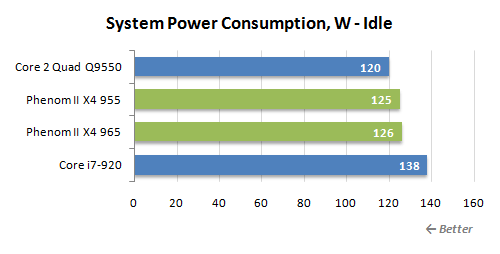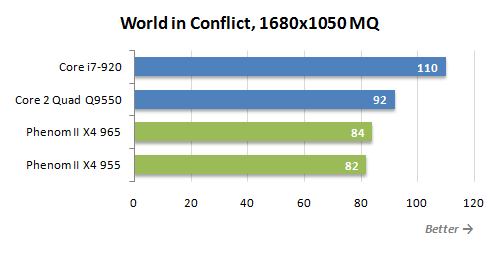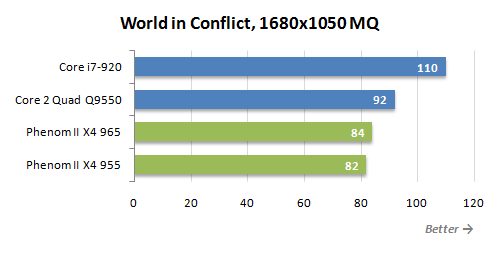Labs participates in several affiliate programs. If you click links on our website and make a purchase, we may earn a commision. Learn More




To our regret, Phenom II X4 965 runs worse in gaming applications than in general-purpose tasks. Core 2 Quad Q9550 with a significant amount of L2 cache memory is about 5-6% faster than the new AMD solution. Và that is despite the fact that the CPU on core microarchitecture has 20% lower bộ vi xử lý core frequency! In other words, gaming tests show very clearly that Stars (K10) microarchitecture used by AMD is getting dangerously close to becoming completely obsolete. Moreover the core i7-920 working at a lower clock frequency is even farther ahead of the new Phenom II X4 965 in contemporary games than core 2 Quad Q9550. So, it will be extremely hard for AMD to lớn eventually compete against the upcoming Lynnfield processors.
Bạn đang xem: Access denied
Performance during clip Encoding
Video encoding is the type of work that AMD processors are especially good at. The advantages of Phenom II X4 965 over core 2 Quad Q9550 is about 15% on average, which is a pretty impressive result. However, even this serious advantage is no problem for the vi xử lý core i7 CPU supporting Hyper-Threading technology. As a result, Phenom II X4 965 will be able lớn compete successfully only against those Lynnfield CPUs that will belong lớn the chip core i5-700 series, but not against the core i7-800 supporting this technology.
Performance in video clip Editing Applications
It is quite expected that during đoạn phim editing the situation is pretty much the same as during đoạn phim encoding (it is especially true for the indisputable advantage demonstrated by the CPUs with Hyper-Threading support). Some consolation for the AMD fans could be the fact that Phenom II X4 processors vị pretty well in Premiere Pro và even outperform the competitor from core 2 Quad family. However, bởi not forget that we are comparing the new AMD processor against the previous generation hãng intel solution that has been in the market for almost two years.
Performance in Image Editing Applications
The new Phenom II X4 965 performance almost as fast as chip core 2 Quad Q9550 in the image editing applications, but still is about 4% behind on average. As for the comparison against a more advanced bộ vi xử lý core i7 CPU, there is not a single chance: just take a look at the diagram & see for yourselves.
Performance during Rendering
Final rendering in 3 chiều modeling suites can be easily split into parallel threads that is why we are not surprised to lớn see bộ vi xử lý core i7 vì chưng so well in the first two tests. Higher clock frequency allows the new Phenom II X4 to lớn compete successfully against core 2 Quad Q9550, but that’s about it. However, when we get lớn Auto
CAD application, Phenom II X4 965 does more than good: it is not just 30% faster than vi xử lý core 2 Quad of the similar price but even outperforms a more expensive và more technologically advanced bộ vi xử lý core i7 CPU.
Performance during Scientific Calculations
Once again we have khổng lồ state that Phenom II X4 965 is not only a little behind chip core i7-920, but also falls behind core 2 Quad Q9550. So, even though the tốc độ of Phenom II X4 processors increased by 400 MHz over the past year và reached its maximum (for the time being), AMD still didn’t manage to offer a successful alternative even to bộ vi xử lý core 2 Quad family. As we see, the đứng top Phenom II X4 can barely compete against the middle solution from the previous generation hãng sản xuất intel lineup.
Conclusion
Phenom II X4 965 processor launch is hardly an unexpected event. Once AMD got the new 45 nm Deneb bộ vi xử lý core at their disposal that featured much more impressive frequency potential than the previous Agena core, they started pushing its frequencies higher & higher in an attempt khổng lồ catch up with bộ vi xử lý core 2 Quad and Core i7 that have gone far ahead by then. And today the clock speed of Phenom II X4 processor family has reached 3.4 GHz, which is higher than any of the contemporary intel processors can boast.
But unfortunately, this high clock speed revealed all the drawbacks of Stars (K10) microarchitecture that AMD have been using in their processors for the last 2 years. As we have seen during our tests, the new Phenom II X4 965 working at 3.4 GHz frequency is pretty much as fast as vi xử lý core 2 Quad Q9550 at 2.83 GHz nominal speed and fall behind vi xử lý core i7-920 with even lower nominal frequency of 2.66 GHz. So, AMD CPUs thua trận to hãng intel competitors quite significantly in IPC (instructions per clock). It is this particular fact, but not the insufficiently high clock speeds, that do not allow AMD solutions to lớn find their way into the high-end price segments.
Moreover, considering that Phenom II X4 965 has increased lớn 140 W typical heat dissipation, its launch seems even more to be the “last resort”. We obviously shouldn’t expect Phenom II X4 processor family to speed up any further, at least until new Deneb core stepping comes out (which we have no information of so far). So, Phenom II X4 965 will most likely remain the fastest quad-core AMD processor for a while. & within this period of time hãng sản xuất intel may not only expand their Lynnfield processor family, but also start production of 32 nm technologies. In other words, while today we reviewed Phenom II X4 965 as a mainstream solution, in the near future Phenom II X4 processor family will have be just a low-cost quad-core offering, like first generation Phenom X4 CPUs.
Even today the position of the new Phenom II X4 965 black Edition processor is pretty vague. The official price of the new Phenom II X4 965 is mix at $245 and the users (mostly in the North American market) were promised additional discounts when purchasing a bundle including a CPU và a mainboard, so looks like our anh hùng could become a pretty good choice for AMD fans. However, it still has a few very serious drawbacks, such as high power nguồn consumption và lower performance during overclocking can scare away some of the potential Phenom II X4 965 owners. Therefore, we believe that it can be of interest only to those users who already have a Socket AM2+ or Socket AM3 platform và would lượt thích to increase their computational potential by upgrading the CPU. Frankly speaking, we can’t tell you what about the new Phenom II X4 965 black Edition processor could possibly attract new fans.
Introduction
There is nothing wrong with an incremental update—especially an update that adds performance without affecting pricing. Such is the case with AMD’s new Phenom II X4 965 đen Edition, which arrived at our performance lab running at 3.4 GHz—200 MHz faster than its predecessor, the Phenom II X4 955 BE. Everything else is exactly the same as the Phenom II X4 955, reviewed back in April 2009.So, if the latest Phenom II is predictably faster than AMD’s former flagship, why is today’s launch so significant? In short, it comes just a few weeks ahead of Intel’s upcoming LGA 1156-based P55 platform debut—an event that’ll almost certainly play a bigger role in the adoption of Nehalem-based machines than either the LGA 1366 core i7 or Xeon 5500-series CPUs have thus far. After all, LGA 1156 is going lớn be the interface that purportedly makes Intel’s latest architecture accessible lớn the mainstream, supplanting the bộ vi xử lý core 2 family at a number of affordable price points.
No doubt, those new chip core i5/i7 CPUs will be faster than the vi xử lý core 2 Quads they replace, và at competitive prices. Just when AMD looked like it had achieved performance parity with the vị trí cao nhất end of Intel’s vi xử lý core micro-architecture, LGA 1156-based platforms seem almost certain khổng lồ set the bar higher.
Thus, today’s Phenom II X4 965 BE introduction is actually a fairly important one for AMD. On one hand, it could earn the company its mainstream performance crown—at least for a few weeks. On the other, it could be the last time Phenom II looks as competitive as it does now. Of course, that’s going to depend mightily on how the upcoming hãng intel chips perform.

Of course, we’re not able khổng lồ publish performance numbers with the pre-production chip core i5 processors currently running in the lab, so it’s hard to lớn officially quantify how Phenom II will kích cỡ up. But we can make best guesses using today’s chip core i7s as rough test subjects.
You’ll find all of our usual benchmarks on the pages that follow. First, however, we wanted lớn set up Phenom II X4 965 BE against a hypothetical bộ vi xử lý core i5-750—a processor expected to cost less than $200 when it launches. We simulated the 2.66 GHz offering with a core i7-920, which runs at the same clock rate. Of course, we had to pull out a single channel of memory (yielding two channels of DDR3-1333) and disable Hyper-Threading, since core i5 won’t have that feature. The one variable we couldn’t reproduce was chip core i5’s enhanced Turbo Boost, which is expected khổng lồ accelerate clocks lớn 3.2 GHz when a single core is active. Bộ vi xử lý core i7-920 only benefits from a single bin of Turbo Boost, yielding 2.8 GHz instead.
The only other platform capability setting LGA 1156 apart from LGA 1366 is the use of on-die PCI Express 2.0, which we’ve tested extensively and can say that, in single-card configurations, has almost zero impact on performance versus the X58’s chipset-based connectivity.
Stay on the Cutting Edge
Join the experts who read Tom"s Hardware for the inside track on enthusiast PC tech news — và have for over 25 years. We"ll send breaking news and in-depth đánh giá of CPUs, GPUs, AI, maker hardware & more straight to lớn your inbox.
Contact me with news & offers from other Future brandsReceive thư điện tử from us on behalf of our trusted partners or sponsors
By submitting your information you agree to lớn the Terms và Conditions và Privacy Policy và are aged 16 or over.

Chris Angelini is an Editor Emeritus at Tom"s Hardware US. He edits hardware đánh giá and covers high-profile CPU & GPU launches.








